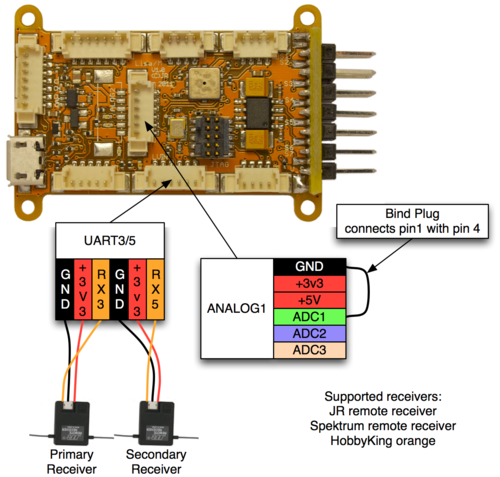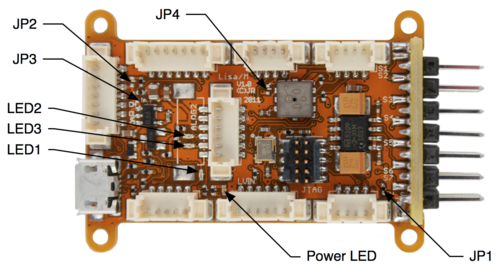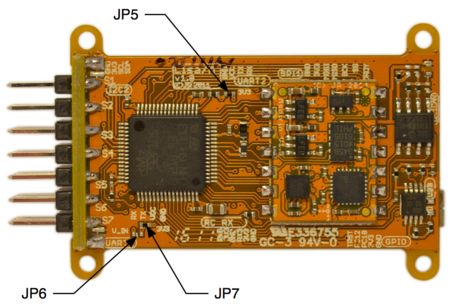Lisa/M/Tutorial/FixedWing
Intro
This article is meant as a tutorial on how to assemble, wire up and mount devices in a fixed wing aircraft based on Lisa/M for a maiden flight on Autopilot. We will use a Multiplex Mentor as example.
For this we need:
1x Mentor complete set
1x Receiver
1x uBlox LEA5 Helix module
1x Input Voltage (7V-12V? Schematic says 25V)
Setup Hardware
IMU
The Lisa/M can be purchased with the Aspirin IMU already soldered to it. Otherwise, you can solder an Aspirin IMU on it yourself.
GPS
On connector UART1 we will connect the GPS receiver. A uBlox LEA-5H will be uses in the basic setup
Servos
ESC
The ESC which stand for Electronic Speed Control to contol the motor speed will be connected to servo pins S1
Aileron
To Pin S2 we connect the left aileron servo. Left side is left is as seen from the back of the airframe. And to pin S5 we connect the right aileron cable
Elevator
On Pin S3 the Elevator servo cable
Rudder
On Pin S4 the rudder servo cable
RC receiver
To be able to test your UAS a RC receiver comes in very handy. One must realize without a receiver an well tuned airframe can fly very well, however for initial tests adding a receiver makes life so much easier. The documentation here will describe how to connect and setup such an RC receiver.
PPM receiver
A modified RC receiver with full PPM out can be used to control the AP board from the ground. How to get a receiver with full PPM out or modify an existing one can be found here.
PPM is at the moment sharing a line with servo6, because it's the way it was wired on a Lisa/L board. It would be trivial to adapt the driver to use another line. look at sw/airborne/arch/stm32/subsystems/radio_control/ppm_arch.c . If you manage to do so please adjust the text on this page also.
Satellite Receiver
Connecting a 2.4GHz Spectrum or compatible receiver
It is very well possible to connect another 2.4Ghz receiver, however the software to interact with that device must at the moment be written by oneself. The advantage of Opensource is that it is possible. Sharing your coding work would be great and in line with the GPL license.
Telemetry
An XBee XSC wireless data module will be used to enable to receive telemetry data. While not needed for fully autonomous flight it is very beneficial to have telemetry data. We will connect the transmitter to connector UART2
Power
Jumpers
It is possible to reconfigure the electrical system on Lisa/M using the supply jumpers. On the boards the Jumper are not real jmper but a spot where we can solder or unsolder a "Bridge" to make or break the connection. In our case the ESC will supply both the servos and the board with power from the main battery. This is the default setup of Lisa/M, so there is no need to solder anything on the board.
- JP1 connects the servo power rail to V_IN rail.
- JP2 connects the battery rail (used by default only for battery voltage measurement) to the V_IN rail.
- JP3 bypasses the +5V voltage regulator and connects V_IN to the +5V rail.
- JP4 connects the V_IN rail to the VCC pin on the UART2 connector.
- JP5 connects the +3V3 rail to the VCC pin on the UART2 connector.
- JP6 connects the V_IN rail to the VCC pin on the UART1 connector.
- JP7 connects the +3V3 rail to the VCC pin on the UART1 connector.
Setup Software
Bootloader
To awake the hardware from sleep and activate the "brain" a so called "bootloader" is used. At the moment there is no bootloader code released yet for Paparazzi and this type of board. If there was, you would not need JTAG to change the software in your Lisa/M and only a USB cable would suffice to upload a new flight plan (just as it is now with a LPC21-based Paparazzi Autopilot board like the TWOG.) If you are good at writing bootloaders for the STM please add your code to the Paparazzi repository.
Uploading Firmware
For the board to perform some sort of action, a "Brain" a.k.a Firmware must be uploaded to the board. This is done by way of a JTAG cable. If you do not have wuch a cable, it is not possible to upload your flightplan firmware to the board. You can order this cable a various hardware suppiers. The Cable design is also opensource, you could opt to make one yourself, but that is not trivial.
IMU Calibration
If you didn't make the board yourself, then you probably got a calibration file (.xml) from your board supplier. If you didn't receive a calibration file then follow the steps for onboard IMU calibration.
Pre-flight Checklist
Double-check that you connected everything correctly. Then switch on your transmitter and power up your board.
Flying
This page is not the one to find and information about that. A look around on this wiki or elswhere on the internet can help you out.


